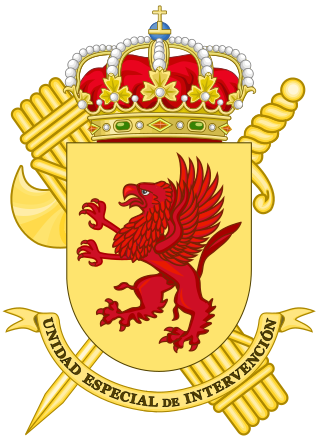
The Armed Forces of Paraguay officially the Armed Forces of the Nation consist of the Paraguayan army, Paraguayan navy and air force.

The Spanish Navy or officially, the Armada, is the maritime branch of the Spanish Armed Forces and one of the oldest active naval forces in the world. The Spanish Navy was responsible for a number of major historic achievements in navigation, the most famous being the discovery of America and the first global circumnavigation. For several centuries, it played a crucial logistical role in the expansion and consolidation of the Spanish Empire, and defended a vast trade network across the Atlantic Ocean between the Americas and Europe, and the Manila Galleon across the Pacific Ocean between the Philippines and the Americas.

The Peruvian Navy is the branch of the Peruvian Armed Forces tasked with surveillance, patrol and defense on lakes, rivers and the Pacific Ocean up to 200 nautical miles from the Peruvian littoral. Additional missions include assistance in safeguarding internal security, conducting disaster relief operations and participating in international peacekeeping operations.

The Norwegian Armed Forces is the military organization responsible for the defence of Norway. It consists of five branches, the Norwegian Army, the Royal Norwegian Navy, which includes the Coast Guard, the Royal Norwegian Air Force, the Home Guard, and Norwegian Cyber Defence Force as well as several joint departments.

The green beret was the official headdress of the British Commandos, a special-forces unit active during World War II. It is still worn by members of the Royal Marines after passing the Commando Course, and personnel from other units of the Royal Navy, Army and RAF who serve within 3 Commando Brigade and who have passed the All Arms Commando Course.

The Unidad Especial de Intervención (UEI) is the only tier one police tactical unit of the Spanish Civil Guard that specialized in counterterrorism and hostage rescue crisis management, high-risk tactical special operations, quick raid to capture or kill high-value targets, and VIP protection.

The Special Forces Corps are the special forces battalions of the Mexican Army. Formerly the Special Forces Airmobile Group (Spanish: Grupo Aeromóvil de Fuerzas Especiales) or GAFE, the SF corps has six regular battalions; plus four specialized units, one of those units is the Fuerza Especial de Reaccion, the other three remain secretive for the public; the motto of the SF Corps is Todo por México.

The Marine Infantry is the naval infantry branch of the Spanish Navy responsible for conducting amphibious warfare. Fully integrated into the Spanish Navy's structure, the branch's history dates back to 1537 when Charles V, Holy Roman Emperor formed the Compañías Viejas del Mar de Nápoles, making it the oldest marine unit in existence.

COMSUBIN is the Italian Navy's special operations unit. Italy was the first nation to use frogmen and human torpedoes. The Royal Italian Navy's Naval Assault Divisions are considered to be the precursor of modern Naval Special Forces. Their record can be traced back to World War I and the operation against the Austrian-Hungarian Battleship Viribus Unitis in Pula Harbour in 1918.
The Amphibious Commandos Group is a special operations force of the Argentine Marine Corps.

The Unidad de Operaciones Especiales was the elite special operations force of the Spanish Navy and marines from 1967 to 2009. In June 2009, the unit was absorbed into the newly formed Special Naval Warfare Force, which inherited the reputation and which continues the record of the UOE. The UOE was formerly garrisoned in the Tercio de Armada in San Fernando, Cádiz and operated under the direct control of the Admiralty and Special Naval Warfare Command. It was thought to comprise approximately 100 men organized into three Operational Teams as well as command and support personnel. The unit has long been one of Europe's most respected special forces.

In Mexico, both the army and navy have special forces groups or elite units.

The Grupo de Operaciones Especiales (GOPES) was the police tactical unit of the Federal Police of Mexico.

The Special Operations Groups are the special operations forces of the Spanish Army.
The CTOE - Centro de Tropas de Operações Especiais, based in Lamego, is a unit of the Portuguese Army with the mission of instructing troops in unconventional warfare and counter-terrorism. Until 2006, it was known as CIOE - Centro de Instrução de Operações Especiais.

The Special Actions Detachment or DAE is the tier one special force maritime unit of the Portuguese Navy. It is part of the Portuguese Marine Corps. Raised in 1985, the DAE is one of the smallest special forces units within the Portuguese Armed Forces. It is responsible for conducting air-sea rescue, amphibious reconnaissance, amphibious warfare, black operation, bomb disposal, CBRN defense, coastal raiding, counterterrorism, direct action, executive protection, hostage rescue, irregular warfare, ISTAR, long-range penetration, JTAC, manhunt high-value target, maritime sabotage, mountain rescue, naval boarding, operation behind high risk enemy lines, special operations, special reconnaissance, tracking targets, underwater demolition, unconventional warfare, other missions in support of Portuguese and NATO armed forces. DAE's mission and training are similar to their American counterparts DEVGRU and the British SBS. DAE often trains with them alongside other SMU counter-terror units.

The Peruvian Naval Infantry (IMAP) is the marine infantry branch of the Peruvian Armed Forces. Consisting of 4,000 personnel, the branch, which falls under the Pacific Operations General Command, includes an amphibious warfare brigade made up of three battalions, internal security units, two troopships, four landing craft and forty armoured personnel carriers. Since 1982, IMAP detachments have been deployed in counterinsurgency operations in the Ayacucho and Huancavelica departments of Peru.
Spain has a long history of combating domestic and international violence and of training units for special warfare or intervention. The following military and police units currently operate under a Special Operations mandate:















